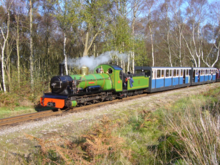Ravenglass and Eskdale Railway
| Ravenglass and Eskdale Railway (R&ER) | |||||||||||||||||||||||||||||||||||||||||||||||||||||||||||||||||||||||||||||||||||||||||||||||||||||||||||||||||||||||||||||
|---|---|---|---|---|---|---|---|---|---|---|---|---|---|---|---|---|---|---|---|---|---|---|---|---|---|---|---|---|---|---|---|---|---|---|---|---|---|---|---|---|---|---|---|---|---|---|---|---|---|---|---|---|---|---|---|---|---|---|---|---|---|---|---|---|---|---|---|---|---|---|---|---|---|---|---|---|---|---|---|---|---|---|---|---|---|---|---|---|---|---|---|---|---|---|---|---|---|---|---|---|---|---|---|---|---|---|---|---|---|---|---|---|---|---|---|---|---|---|---|---|---|---|---|---|---|
|
Railway junction around camps; Sellafield & Ravenglass (right), 1914
| |||||||||||||||||||||||||||||||||||||||||||||||||||||||||||||||||||||||||||||||||||||||||||||||||||||||||||||||||||||||||||||
| Route length: | 11.3 km | ||||||||||||||||||||||||||||||||||||||||||||||||||||||||||||||||||||||||||||||||||||||||||||||||||||||||||||||||||||||||||||
| Gauge : | 381 mm ( Liliputbahn ) | ||||||||||||||||||||||||||||||||||||||||||||||||||||||||||||||||||||||||||||||||||||||||||||||||||||||||||||||||||||||||||||
| Maximum slope : | 25 ‰ | ||||||||||||||||||||||||||||||||||||||||||||||||||||||||||||||||||||||||||||||||||||||||||||||||||||||||||||||||||||||||||||
|
|||||||||||||||||||||||||||||||||||||||||||||||||||||||||||||||||||||||||||||||||||||||||||||||||||||||||||||||||||||||||||||
The Ravenglass & Eskdale Railway (R&ER) is now a 7 mile (11.3 km ) long miniature railway - museum railway in Cumbria , North West England, and runs from Ravenglass on the Cumbrian Coast Line through the Eskdale Valley to Boot .
history
Originally designed in a 914 mm (3 ft ) gauge , the original line was officially opened for freight (transporting iron ore ) on May 24, 1875 . Passenger traffic took place from 1876 to 1908, making it the first narrow-gauge railway for public passenger transport in England. In 1913 it was shut down for the first time due to the decreased demand for iron ore, and - initiated by two enthusiasts - re- gauged to 381 mm (15 in ) on August 24, 1915, reopened for passenger and freight traffic (mainly granite ) become. Complete re-gauging was not completed until 1917. For the transport of goods there was a three-rail track between Murthwaite and Ravenglass for a while. At the end of World War II , during which passenger traffic was again suspended, the railroad was bought by the Keswick Granite Company, but with the cessation of granite mining in 1953 it was to be sold again. A few years later, in 1960, passenger traffic also ended.
During this period, enthusiasts founded the "Ravenglass and Eskdale Railway Preservation Society", which was to ensure continued operation on the basis of the model of a private-public partnership : the railway was to become privately owned, while the non-profit organization would organize support for the entire operation. It was possible to implement this model at the last moment with the help of the private commitment of two railway enthusiasts and to this day the construction and operation of the railway are secured by the "Ravenglass & Eskdale Railway Co. Ltd." In 1960, the museum railway started operating immediately after the end of public operations.
business
The museum railway is now operated almost all year round from February to December, with up to 14 pairs of trains a day in summer ( 2010/11 summer timetable ). Every year around 120,000 people, mostly tourists, use the R&ER.
The route begins at Ravenglass railway station ( Ravenglass railway station , km 0.0), intermediate stops are Muncaster Mill (km 1.6), Miteside Halt (km 2.8), Murthwaite Halt (km 4.4), Irton Road ( km 6.8), Eskdale Green (km 7.6), Fisherground Halt (km 8.9) and Beckfoot (km 10.5). It ends in Dalegarth for Boot (km 11.3), about 300 m from Boot , a place with about 15 inhabitants, from which there are hiking trails in the charming surroundings, e.g. B. to Sca Fell , the second highest mountain in Great Britain.
The single-track line has three alternative or intersection options, two of which are operational turnouts (Miteside Loop and Fisherground Loop), and the third is through the Irton Road station. All operating points are equipped with fallback switches. The operation is controlled from Ravenglass via telephone instructions ( radio control train order ) as train control , in particular via the use of the single-track route between the switches. Fixed signals (with the exception of Ravenglass) are not available.
vehicles
The oldest locomotive used is the D1 '(engl 0-8-2.) - steam locomotive River Irt 1927, with parts of it come from a machine now scrapped from 1894, while the latest diesel-hydraulic locomotive BB Douglão from the year 2005 is. The railway has a total of 8 steam locomotives (including 3 in operation and 1 operational), 5 diesel-mechanical locomotives (one in operation, 4 operational), 2 locomotives with gasoline engines (inoperative), 1 battery-powered electric locomotive (inoperative) and 1 diesel -hydraulic locomotive. A total of 49 passenger cars and 21 different service wagons are available for operation.
Others
On October 3 and 4, 1998 the steam locomotives River Mite (1'D1 ', built in 1966) and Northern Rock (1'C1', built in 1976), as well as the diesel locomotive Cyril (diesel-mechanical, built in 1985) operated by R&ER in As part of a guest assignment on the Dresden Park Railway, which is built in the same gauge. The transport of the locomotives to Germany by truck was taken over by Royal Mail free of charge.
Web links
- Website of the Ravenglass and Eskdale Railway Company Ltd.
- Ravenglass & Eskdale Railway Preservation Society website
- Photos of the railroad at flickr group
- Website of The Cumbria Directory - Ravenglass Railway Museum
- Photo gallery from the guest assignment at the Dresden Park Railway in 1998
Individual evidence
- ↑ http://www.ravenglass-railway.co.uk/timefares.html , last accessed on June 30, 2011
- ↑ http://www.parkeisenbahn-dresden.de/index.php?snav708&gastloksgb98 , last accessed on June 30, 2011



